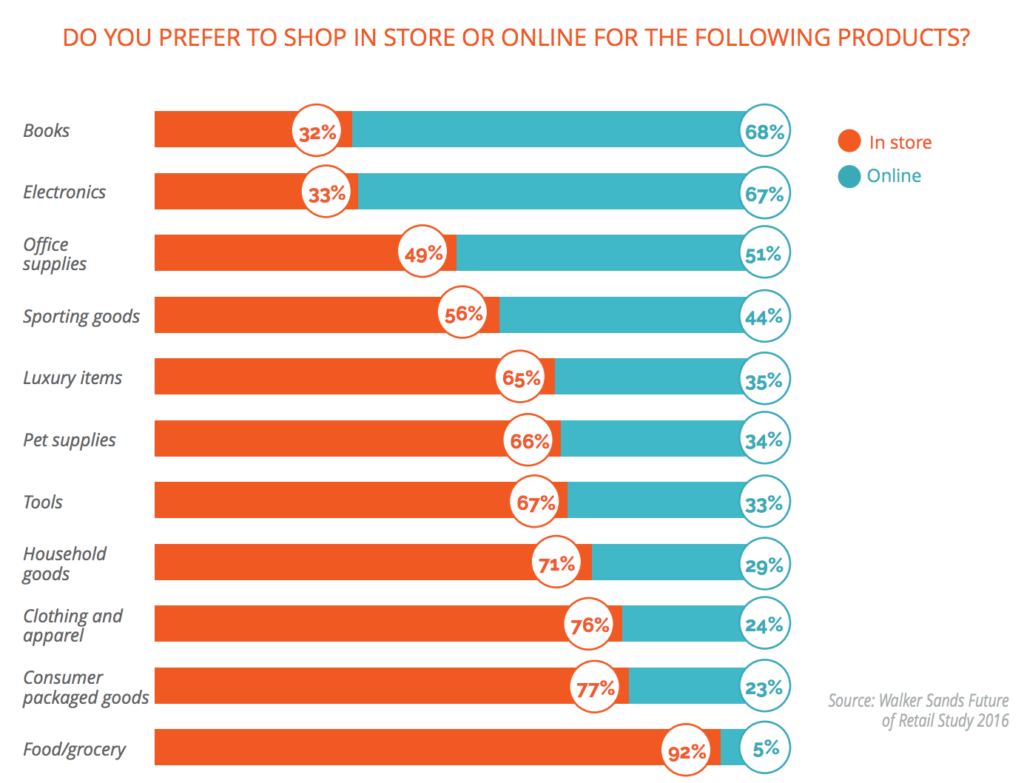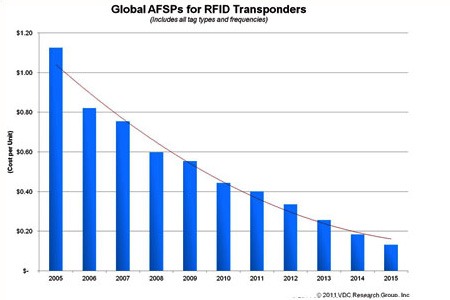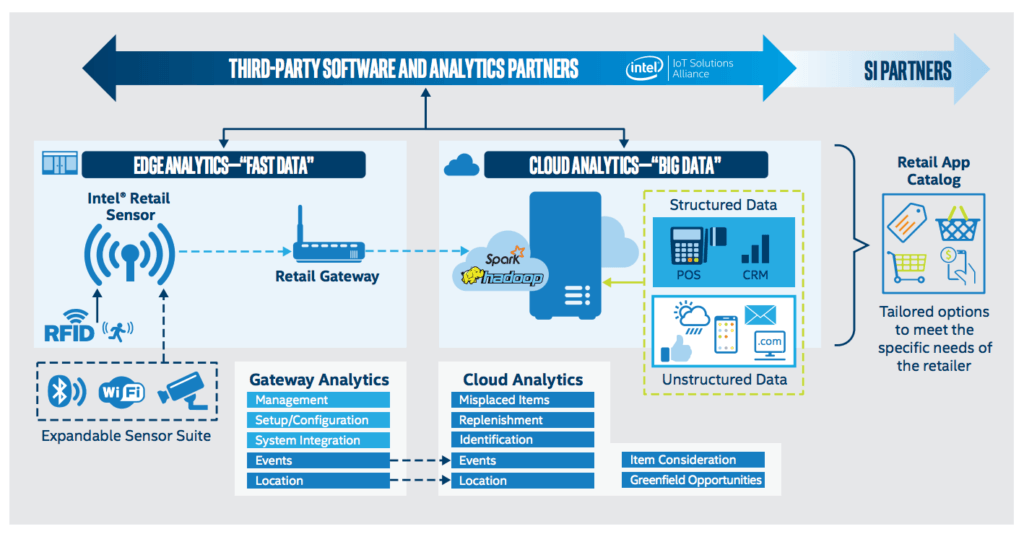We DO have that in stock: Levi Strauss brings the Internet of Things to stores

Levi Strauss is trying to revitalize the in-store shopping experience by leveraging the Internet of Things (IoT) and Big Data to more accurately assess inventories and give its employees more time to interact with customers.
Retail’s Inventory Pains
Apparel shopping experiences suffer from the uncertainty of inventories. Too often, employees will tell customers “let’s check in the back”, only to discover a stockout. Consequently, some customers have migrated to ecommerce, where product availability is more certain. The majority (77%), however, prefer to shop in stores, where costumers can try on items and combine them with other items [1].
Fig. 1. In-store versus online preferences for shopping by product category [1]
A study from Auburn University revealed that the average retail inventory accuracy was only 63 percent [2]. Retail store employees cover for this uncertainty by foraging for misplaced items and monitoring inventories constantly, but this reduces the amount of time they interact with customers. Monitoring in-store inventories more accurately – ideally in real-time – would boost sales performance and customer satisfaction, for it translates to more time for employees to face customers, which in turn translates to a better shopping experience that customers want.
The Internet of Things and Big Data to the Rescue?
Retailers have turned to Electronic Product Code (EPC)-enabled item level Radio Frequency Identification (RFID) technology for better in-store inventory tracking. While RFID technology is not new, the price of an RFID has decreased from $1.00 per tag in 2005 to below $0.15 today – cheap enough to add them to all items in a store [3] [4].
Fig. 2. Global average factory selling prices for RFIDs, by year [3] [4]
Having many RFIDs transmitting data, however, results in large volumes of data to process. Until recently, organizing and computing this data was time-consuming and expensive, but the emergence of Apache Hadoop, a software framework released in December 2011, has made large-scale data storage and processing feasible. With a “cluster” of computers running Hadoop, software developers could write applications to analyze the data, draw insights, and create visualizations for decision-makers [6]. With Apache Spark, a framework released in mid-2014, data scientists could process data even faster and apply complex machine learning algorithms more frequently [7].
Fig. 3. Intel’s retail inventory solution using the Internet of Things (RFIDs) and Big Data (Hadoop/Spark)
Levi Strauss and Intel’s Retail Sensor Platform
Levi Strauss in a clothing company known for its Levi’s brand of jeans. The company is vertically integrated and owns 656 brick-and-mortar stores. These stores are key to its retail experience, as they allow Levi Strauss to tell its brand story [8].
Seeking a better in-store experience, Levi Strauss sought Intel for a way to more accurately assess retail inventories. Intel’s solution, the Retail Sensor Platform, uses RFID tags woven into items to monitor their location. Sensors receive data transmitted from the RFIDs and feed it to Intel’s Trusted Analytics Platform (TAP), which analyzes the data and generates insights for store employees and the supply chain [9] [10] [11]. This delivers a more real-time view of inventories, and even allows employees to locate misplaced items. Supply chain is notified of impending stockouts and can replenish stocks quickly [12].
Fig. 4. Intel’s Retail Sensor Platform
The results are impressive: inventory accuracy increases to above 95 percent [2] (and potentially 100 percent [9]), and stockouts decrease by up to 50 percent [2]. Salespeople spend less time monitoring inventories and more time facing customers, and avoid missed opportunities where the customer leaves having not found the right item in time. Results have shown that for every 3% improvement in inventory, there is approximately 1% in sales uplift [13]. This means that by adopting this solution, same store sales could increase by 10 percent on average.
Additional Opportunities for Retail
The Internet of Things can provide more benefits for Levi Strauss beyond improved inventory management. Within its existing solution, additional insights could be drawn from the RFID data. With each item tagged via RFID, Levi Strauss can learn more about in-store shopping patterns: which areas are most active, and where do customers go once they have grabbed an item. Even more nuanced insights could be drawn from machine learning. Furthermore, checkout services may be unnecessary, as employees would know which items are in the customer’s basket. Employees would have even more time to service customers [14] [15].
Other solutions using IoT hardware could be adopted that would benefit the customer more directly. Levi Strauss should explore installing retail beacons at store entrances. These beacons use Bluetooth to identify nearby customers and can transmit messages or special offers [1] [16]. A customer walking into the store could be informed that the newest Levi’s items are available for her, in her size, to try on.
Levi Strauss has shown that by embracing the Internet of Things, combined with Big Data techniques, it improved its operations by having greater control over its inventories. This digital transformation empowered employees with insights to provide superior service, and gave customers a stress-free in-store shopping experience.
(799 words)
Sources
- Walker Sands Communications. “Walker Sands Future of Retail 2016. Reinventing Retail: Four Predictions for 2016 and Beyond.” http://www.walkersands.com/images/files/image/pdf/Walker-Sands-2016-Future-of-Retail-Four-Key-Takeaways-for-Retailers-in-2016-and-Beyond-Whitepaper.pdf.
- GS1 US, Auburn University RFID Lab. “EPC-enabled Item Level RFID Transforms the Omni-Channel Shopping Experience.” 2014. https://www.gs1us.org/gs1-us-library/command/core_download/entryid/1529.
- Sower, Victor, Kenneth Green, Pamela Zelbst, and Morgan Thomas. “U.S. Manufacturers Report Greater RFID Usage.” RFID Journal. http://www.rfidjournal.com/articles/pdf?9589.
- VDC Research. “RFID Transponders.” 2011.
- Beecham Research, and Doug (Internet of Business) Drinkwater. “The Future of Retail Through the Internet of Things (IoT).” Intel Corporation. Feburary 2016. https://www-ssl.intel.com/content/www/us/en/retail/solutions/documents/future-retail-through-iot-paper.html.
- The Apache Software Foundation. What is Apache Hadoop? http://hadoop.apache.org/.
- The Apache Software Foundation. “Apache Spark FAQ.” Apache Spark — Lightning-Fast Cluster Computing. https://spark.apache.org/faq.html.
- Levi Strauss & Co. “2015 Annual Report.” http://www.levistrauss.com/investors/annual-reports/.
- Intel Corporation. “Increasing Profitability for Brick-and-Mortar Retailers: Intel Retail Sensor Platform Delivers Near 100% Inventory Accuracy.” https://www-ssl.intel.com/content/www/us/en/retail/solutions/documents/retail-sensor-platform-paper.html.
- Intel Corporation. “Intel Retail Sensor Platform Solution Brings Digital Insight.” https://www-ssl.intel.com/content/www/us/en/retail/solutions/retail-sensor-platform.html.
- Intel Corporation. “About Trusted Analytics Platform (TAP).” http://trustedanalytics.org/about-overview/.
- Goldman, Sharon. How the internet of things is revolutionizing retail. June 30, 2016. http://www.cio.com/article/3090123/internet-of-things/how-the-internet-of-things-is-revolutionizing-retail.html.
- Kim, Eugene. “Intel is helping Levi’s save a ton of money by tracking every movement in a retail store.” Business Insider. November 3, 2015. http://www.businessinsider.com/intel-helps-levis-track-store-data-2015-11.
- Gregory, Jonathan. “The Internet of Things: Revolutionizing the Retail Industry.” Accenture Strategy. https://www.accenture.com/_acnmedia/Accenture/Conversion-Assets/DotCom/Documents/Global/PDF/Dualpub_14/Accenture-The-Internet-Of-Things.pdf.
- Meunier, Francois, et al. “The “Internet of Things” is Now: Connecting the Real Economy.” Morgan Stanley Blue Paper. April 3, 2014. http://www.technologyinvestor.com/wp-content/uploads/2014/09/internet-of-Things-2.pdf.
- Goldstein, Phil. “Retail Beacons Are Becoming More Popular, but Their Effectiveness Is Debated.” BizTech Magazine (CDW). August 8, 2016. http://www.biztechmagazine.com/article/2016/08/retail-beacons-are-becoming-more-popular-their-effectiveness-debated.







The additional applications of RFID to the in-store experience are really cool. I feel like it would save so much time in the checkout process if the cashier already had my basket of items entered into the POS and all they would need to do would be to accept my payment. However, I feel like I am a little concerned that these RFID’s aren’t disabled once I leave the store. I realize that we are living in a trackable world and that data on my movements are being transmitted through my smartphone, but I wonder if people are going to be turned off by chips woven into their clothes. It is hard to see Levi’s forgoing this opportunity if they are going to experience a 1% increase in sales for every 3% increase in inventory management so I wonder how they will approach any reservations from the customer.
I’d be interested to know if Levi’s has been able to roll out this technology to its other retail partners, like Macy’s or Nordstroms, where Levi’s has “store-within-a-store” areas in these department stores. Furthermore, I wonder about the potential applications for the dressing room – is Levi’s taking advantage of the RFID technology so that customers could request additional sizes a digital interface (like an iPad) from inside the dressing room?
Thanks for the interesting article! I agree with John Smith that it is odd these RFID tags still gather data after a customer has left the store. I imagine most people (myself included) are not aware of this and it therefore does not affect their interaction with the store/brand. I do see how this is very useful for tracking inventory movement and prevents items from getting lost or stolen. I think the idea that Levi could “push” notifications about coupons or in-stock sizes to nearby consumers, but I also wonder if this is at odds with the discomfort cited above that consumers may feel when they are being constantly tracked. Is there a way to reconcile the benefit with the drawback?
I used RFID tags extensively in the military to track shipments of containers, so it is very interesting to see its application in the retail business and even more interesting to see how Intel had automated the toughest part of the RFID capability- the interpretation of the data. Via proprietary hardware as well as cloud computing Intel came up with a solution that saved retail outlets HOURS of work. I would have to have Soldiers manually query and update the locations of each of our shipments on a single document- it is incredible to see that Intel can cater the data to exactly what LeviStrauss needs to keep tabs on inventory levels and how consumers are purchasing.